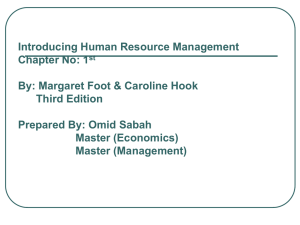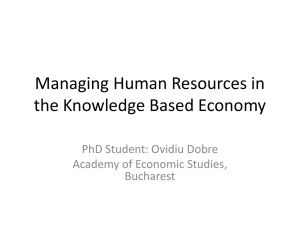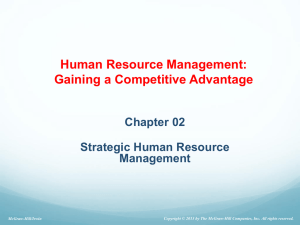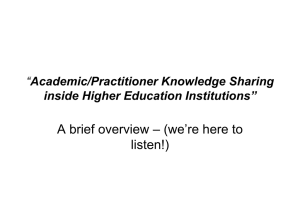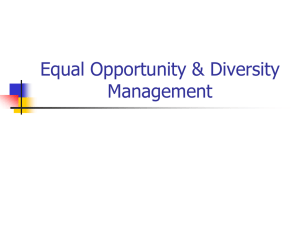The Trouble with HRM
advertisement
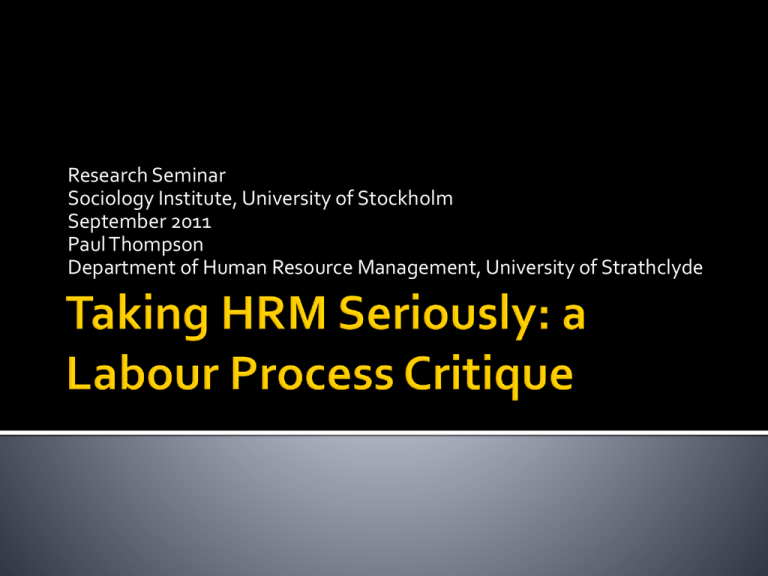
Research Seminar Sociology Institute, University of Stockholm September 2011 Paul Thompson Department of Human Resource Management, University of Strathclyde ‘After over two decades of extensive research, we are still unable to answer core questions about the relationship between human resource management and performance’ (Guest 2011: 3) ‘The human resource management profession faces a crisis of trust and a loss of legitimacy in the eyes of its major stakeholders. The two-decade effort to develop a new “strategic human resource management” (HR) role in organizations has failed to realize its promised potential of greater status, influence, and achievement’. (Kochan 2006) Ripe for critique, but on what basis? Delbridge: HRM research can address ‘its conservatism and its irrelevance’...’through engagement more directly and productively with proximate social science disciplines and, in particular, critical management studies’ (2010) Legge: Most HRM models emphasise the organisation’s culture as the central activity for senior management – with HR departments as primary agents of change HRM is treated as a cultural construction seeking to refine the meaning of work relations between employees and the organisation: ‘a medium for manufacturing meaning in the process of culture management’ (Keenoy and Anthony 1992: 237) Alvesson and Karreman – a cultural-symbolic perspective HRM works not because it is technically efficient, but as a rationality surrogate that creates ascription of positive meaning and suspension of disbelief ‘From the mid-1980s onwards, the increasing emphasis on culturally-based forms or organizational control – in which symbolically-mediated bodies of regulation, monitoring and disciplining at work became the major concern…’ (Reed 2010) Soft HRM and corporate culture were linked to the shaping of employee subjectivity and production of various ‘designer’ (Casey, 1995); ‘engineered’ (Kunda, 1992) or ‘enterprising’ selves (du Gay 1996) Emphasis on new disciplinary regimes ‘founded on the internalization of self-regulation, calculation and control in which externally imposed authority and discipline becomes much less significant’ (Grant et al, 1998: 202). Townley and HRM as a power-knowledge discourse: ‘HRM’s role in providing a nexus of disciplinary practices aimed at making emplyees’ behaviour and perfromance predicatble and cacluable..’ (1993: 538) Moving on from culture change, but the cultural techniques associated with soft HRM continue to be associated with the supposedly successful regulation of employee identity ‘Identity regulation encompasses the more or less intentional effects of social practices upon processes of identity construction and reconstruction. Notably, induction, training and promotion procedures are developed in ways that have implications for the shaping and direction of identity’ (Alvesson and Willmott, 2002: 621). HRM does have a symbolic dimension, e.g. adoption or promotion of ‘best practices’ or being a ‘good employer’ can have an effect on share price (Palmer and Hardy 42) Assumes that the functioning of HRM can be found in its discourse, and those discourses and technologies are largely disconnected from context – as a will to knowledge : the ‘re-reading of HRM’ (Townley 537) is largely new languages for old practices One result – a complete lack of interest in the actual effectiveness of the ‘tools’ of HRM or the ‘truth or falsity of discourse’ and therefore with ‘mainstream HRM’ Limited engagement does not mean absence of connection to mainstream HRM ‘Soft HRM’ and mutuality models, where commitment and investment in human capital is seen as central to competitive advantage (Appelbaum et al, 2001; Pfeffer 1994, 1998) Universalistic, best practice models - commitment model the defining feature of HRM. It replaces the control or compliance model: ‘’create the conditions for employees to display internally self-driven initiative and take more responsibility for monitoring their own behaviour’ (Wood 1995: 216). Culture declines, branding emerges; geared primarily towards corporate reputation, but employees encouraged to ‘live the brand’ ‘The identity of the firm as an employer. It encompasses the firm’s value system, policies and behaviours toward the objectives of attracting, motivating, and retaining the firm’s current and potential employees’ (Ainspan and Dell, 2001: 3). Strategic HRM and high performance work practices – a different take? Best practices – lists and clusters A difference between commitment-seeking and commitment generating practices that ‘energise employee commitment’ (Kaufman 2010) A difference between high involvment work practices and high commitment employment practices? The underpinning human capital narrative: labour as asset not cost, at least to the core rather than contingent workforce (hard HRM) RBV – ‘human capital represents one of the last and best sources of competitive advantage’ (Kaufman 2010) HR tools manage human capital pool. Commitment aligns interests and mobilises discretionary effort The unproven link between high commitment (and other HRM effects) and high performance The empirical critique: minority of firms, minority of practices: emphasis on form not content; but doesn’t tell us much, if anything about commitment ‘..it would appear that, on average, the full adoption of the paradigm may not yield outcomes that are appreciably more positive than those yielded by pratices that have long been associated with good management, including professional personnel practices (e.g. job ladders, employment security, gievance systems, formal training, above-market pay), group work organization, information sharing and accomodative union relations’ (Godard 2005: 162) The historic weakness of HRM discourse is its attachment to the concept of human capital. Universal models do have a conception of the environment as driver, but it is a weak and impoverished one ‘Approaches to constructing the independent variable in HPWS in which researchers aggregate their perceptions of “best practices” without regard to a specific context, are therefore fundamentally contentious’ (Boxall and Macky 7) Economically rational low road choices ‘…it might be argued that, in capital-intensive manufacturing, a HPWS model is preferable as labour costs are a small proportion of total costs and high quality, committed labour can facilitate the optimum exploitation of high-cost plant and materials’ (Legge, 2005b: 229). Cost minimisation /leadership strategies External fit may undermine internal fit Acceptance of a ‘differentiated workforce’: talent management, targeted investment in human capital, ‘employee of choice’ rather than ‘employer of choice’ (Becker, Huselid and Beatty 2009) The post-structuralist version of best fit ‘because knowledge workers have so much autonomy in how they apply their skills, organisations must increasingly focus on enacting effective normative structure to shape employees’ subjective identity and orient it towards the achievement of organisation goals’ (Alvesson 2001) Better, but not adequate: external fit based on product market variation; naivety about cost minimisation; ‘competitive pressures’ neglect of capital markets in constructing market discipline High performance does not necessarily protect any firm or group of workers A political economy approach, but which one? Divergent interests and mutual gains in the employment relationship Employment relations actors as purposeful and knowledgeable, constrained actors not identityseeking idiots HRM and the agency relationship A different line on commitment: ‘There is a danger in treating the normative as a separate category. All control practices have normative dimensions. Even if not explicitly designed to engage with ‘hearts and minds’, their operation and effects will do so’. (Thompson and van den Broek 2010: 6) The shift from managerial to financial capitalism, from extraction and realization of value in capital rather than (the management of labour in) product markets The promises of private equity Cost cutting and work intensification Financial intermediaries, owners and local managers: levers and agents, who is making ‘economically rational’ decisions? Disconnected capitalism: impact on local bargains. Divergence of work and employment systems Applebaum and Batt: the turnaround ‘Under the shareholder model of financial capitalism, then, the focus of investment activities shifted – from that of investing in productive enterprises to that of extracting money from companies for further trading activities, which yielded higher returns’ (2010, 7) Organisations are increasingly dominated by the principles of ‘market rationalism’ and normative interventions promoting commitment and focusing on cultural change are becoming less relevant or marginalised (Kunda and Ailon-Souday, 2005; Thompson, 2003). Financialization as a variant of market discipline Can we explain performance outcomes without HCM? Capelli and the ‘frightened worker model’ Old and new forms of insecurity: ‘overall, the results provide reasonably good evidence that employees exert high levels of effort in insecure conditions’ (McGovern et al) ▪ Consistent with the ‘dark side’ of HRM and lean production perspectives from labour process research Weakness of capacity to resist, compliance as a substitute for commitment and trust: to what extent is effort discretionary? Market individualism and the ‘free worker’ So, why HPWP? ‘more intensive investment in raising the performance of existing employees’ (McGovern et al, 145). It does extract effort and in a variety of (selective) ways and contexts. In ‘marketized’ systems is HRM necessary? Trends towards outsourcing and HR service centres Structural isolation and disappearance from shop floor ‘You are so out of touch, so out of touch! You’re meant to be in charge of the human beings in this company. You’re actually meant to be in charge of the people, not the profit or the margin or whatever else, you’re actually meant to be in charge of the actual human beings in the building’. (Avatar employee) Kochan: HR from steward of the social contract to business partner and handmaiden to corporate elite Nobody wants to be employee champion (Francis and Keegan 233); employees know where HR stands and they don’t like it A more professional, more ethical, more reflexive and balanced HR – don’t hold your breath. The romance of human capital, self-interest of the profession SHRM is fraught with mis-specification…. Is a management-centric theory oriented towards a commitment/ILM type of employment model that gives over-emphasis to psychological factors’ (Kaufman 2010: 16) There is no realistic path to internal reform of HRM; regulation of employment systems Is there any sense in which ‘people are our most important asset’ is true? An asset with value rather than a valued asset. The commitment chimera, commitment to what? ‘For employers there is a need to recognise that the promise of the high performance paradigm may be false one. It may make better sense for most to adopt what have always been good management practices, possibly with some alternative work practices grafted on. These practices may not yield the high levels of commitment promised by the high performance paradigm, but they be expected to yield reasonable levels of consent and realistic levels of performance’ (Godard 2005: 170) Abandon the idea that HRM is a distinctive approach to managing people at work. This is consistent with Boxall and Purcell’s preference for ‘analytic HRM’ Who should be engaging with whom? The blind alley of ‘critical HRM’ Boxall, P. And Macky, K. (2009) ‘Research and Strategy on High-Performance Work Systems: Progressing the High Involvement Stream’, Human Resource Management Journal, 19/1:3-23. Thompson P. (2003) ‘Disconnected Capitalism: or Why Employers Can’t Keep Their Side of the Bargain’, Work, Employment and Society. Vol 17, no.2 pp. 359-378 Pfeffer, J. (1994). Competitive Advantage Through People. Boston: Harvard Business School Press. Huselid, M. (1995). ‘The Impact of Human Resource Management Practices on Turnover, Production and Corporate Financial Performance’, Academy of Management Journal, 38: 635-672. Godard, J. (2004) ‘A Critical Assessment of the High Performance Paradigm, British Journal of Industrial Relations, 42.2: 349-378. Boxall, P., and Purcell, J. (2003). Strategy and Human Resource Management, London: Palgrave. Boxall, P., Purcell, J. and Wright, P. (2006) ‘Human resource management: scope, analysis, and significance’, in the Oxford Handbook of Human Resource Management, Edited by P. Boxall, J. Purcell and P. Wright, Oxford University Press. Francis, H. and Keegan, A. (2006). ‘The changing face of HRM: in search of balance’. Human Resource Management Journal, 16: 3, 231–249. Thompson, P. and van den Broek, D. (2010) ‘Managerial Control and Workplace Regimes: An Introduction’, Work Employment and Society E-Special 1: 1-12. Townley, B. (1993). “Foucault, Power Knowledge, and its Relevance for Human-Resource Management”. Academy of Management Review 18(3): 518-545. Wood, S. and V. T. Albanese (1995). “Can We Speak of a High Commitment Management on the Shop-Floor” Journal of Management Studies 32(2): 215-247. Legge, K. (2005a). Human resource management: rhetorics and realities. Basingstoke, Palgrave Macmillan. Legge, K. (2005b). “Human Resource Management” in Oxford Handbook of Work and Organization. S. Ackroyd, R. Batt, P. Thompson and P. Tolbert. (eds) Oxford: Oxford University Press: 220-241. Keenoy, A. and P. D. Anthony (1992). “HRM: Metaphor, Meaning and Morality” Reassessing HRM. in P. Turnbull and P. J. Blyton (eds). London: Sage: 233-255. Kochan, T. (2006) ‘Social Legitimacy of the Human Resou8ce Management Profession: A U.S> Perspective’, in Oxford Handbook of Human Resource Management,, P. Boxall, J. Purcell and P. Wright (eds.), Oxford: Oxford University Press. Kunda, G. (1992). Engineering culture: control and commitment in a high-tech corporation. Philadelphia, Temple University Press. Kunda, G. and G. Ailon-Souday (2005). “Managers, Markets and Ideologies: Design and Devotion Revisited” in Oxford Handbook of Work and Organization. S. Ackroyd, R. Batt, P. Thompson and P. Tolbert. (eds) Oxford: Oxford University Press: 200-219. Guest. D. (2011) Human resource management and performance: still searching for some answers’ , Human Resource Management Journal, Vol 21, no 1, 2011, pages 3–13 Karreman, D. and M. Alvesson (2004). “Cages in tandem: Management control, social identity, and identification in a knowledge-intensive firm” Organization 11(1): 149-175. Kaufman, B. (2010) ‘SHRM Theory in the Post-Huselid Era: Why It is Fundamentally Mis-Specified’, Industrial Relations, 49 (2): 286-313. MoGovern, P., Hill, S., Mills, C. And White, M, (2007) Market, Class and Employment, Oxford: Oxford University Press. Casey, C. (1995). Work, self and society: after industrialism. London: Routledge. Alvesson, M. and H. Willmott (2002). “Identity regulation as organizational control: Producing the appropriate individual” Journal of Management Studies 39(5): 619-644. Batt, R. and Applebaum, E. (2010) ‘Globalization, New Financial Actors, and Institutional Change: Reflections on the Legacy of LEST’, Paper to Colloquium, Université de Provence, 27-28 May. Ainspan, N. and D. Dell (2001). Engaging Employees Through Your Brand. New York: The Conference Board, Inc.



